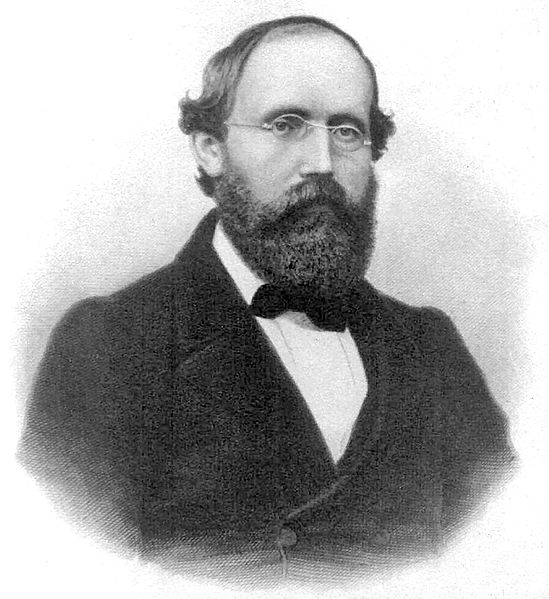Why is the complex plane shaped like it is?
There is a really important aspect of complex numbers that depends on the complex plane having exactly this shape: complex multiplication.
Complex numbers can not only be characterized in cartesian coordinates by a real part and an imaginary part, but also in polar coordinates by a length and an angle.
You know that for any $z \in \mathbb{C}$ there exist $x, y \in \mathbb{R}$ such that $z = x+i\cdot y$, right? $x$ is the real part and $y$ is the imaginary part? Well, there also exist $r, \varphi \in \mathbb{R}$, $r \geq 0$ such that $z = r\cdot(\cos\varphi + i\sin\varphi)$. Here, $r$ is called the length or absolute value of $z$ and $\varphi$ is called the angle or argument, measured counterclockwise from the positive real axis.
We can use cartesian coordinates to add complex numbers: $$(x_1+i\cdot y_1) + (x_2+i\cdot y_2) = (x_1+x_2) + i\cdot(y_1+y_2)$$
We can use cartesian coordinates to multiply complex numbers:
$$(x_1+i\cdot y_1)\cdot (x_2+i\cdot y_2) = (x_1x_2-y_1y_2) + i\cdot(x_1y_2+y_1x_2)$$
However, we can also use polar coordinates to multiply complex numbers:
$$(r_1(\cos\varphi_1 + i\sin\varphi_1))\cdot(r_2(\cos\varphi_2 + i\sin\varphi_2)) = (r_1\cdot r_2)(\cos(\varphi_1+\varphi_2) + i\sin(\varphi_1+\varphi_2))$$
So to multiply two complex numbers in polar coordinates, you multiply their lengths and add their angles. I personally think this is incredibly helpful for visualization, and this also shows why the imaginary axis needs to be at a right angle to the real axis: since the angle of $-1$ is $180^\circ$, the angle of $i$ needs to be $90^\circ$ or $270^\circ$.
The complex plane is a model (or more formally, an isomorphism) with very nice properties, such as $\arg(zw)=\arg(z)+\arg(w)$ or, in more advanced complex analysis, winding numbers.
Could there be a "better" representation? Maybe. And, in any case, you should be clear about what means "better" for you, that is, what you want to do with this representation.
What is sure is that, since Gauss began to use the complex plane, deep, useful and beautiful applications have been found.
We choose pictorial representations so that algebraic properties (such as associativity and commutativity of addition and multiplication) have coherent geometric interpretations.
For example, the traditional number line associates to each real number $a$ a displacement from $0$ in such a way that for all real $a$ and $b$,
Addition corresponds to concatenation of displacements, subtraction $b - a$ is the displacement taking $a$ to $b$, and $|b - a|$ is the distance from $a$ to $b$;
Multiplication by a positive real $c$ corresponds to scaling by $c$ (fixing $0$) and multiplication by $-1$ is the (distance-preserving) reflection across $0$;
Moving rightward corresponds to the order relation.
There are, however, other geometric ways to represent the field of real numbers. To name one, identify the real number $a$ with the line of slope $\tanh a$ through the origin in the Cartesian plane, and let the reals act by boost transformations. This is how velocities add in special relativity.
The Euclidean plane [*] can be coordinatized by fixing an origin $O$, two mutually-perpendicular oriented lines $X$ and $Y$ through $O$, and a unit of length. (Conventionally, we take $X$ horizontal and oriented to the right; $Y$ vertical and oriented upward.) If $P$ is an arbitrary point, there is a unique line $\ell_{Y}$ through $P$ and parallel to $Y$ by the parallel postulate; the unique point of intersection of $\ell_{Y}$ with $X$ defines the $x$-coordinate of $P$. The $y$ coordinate of $P$ is defined similarly.
The point $P$ is thereby identified with an algebraic address: the ordered pair $(x, y)$ of real numbers. Doing so furnishes a bijective correspondence between the Cartesian plane (the Euclidean plane with the extra structure of the origin, two oriented lines, and a fixed unit of length) and the set $\mathbf{R}^{2}$ of ordered pairs of real numbers.
Because each axis is effectively a number line, the algebraic operations of vector addition acquire geometric meaning, via the parallelogram law for vector addition and the operation of radial scaling centered at the origin for scalar multiplication.
Now, what about complex numbers? Identifying $\mathbf{C} \simeq \mathbf{R}^{2}$ is natural enough: $x + iy \leftrightarrow (x, y)$. Because $i^{2} = -1$, we wish to represent $i$ as a geometric operation that, performed twice in succession, has the effect of multiplying by $-1$, i.e., of rotating the plane by a half-turn about the origin. A quarter turn about the origin accomplishes this. By an additional convention, we (usually) take the counterclockwise rotation, so that the positive $x$-axis rotates to the positive $y$-axis. (We could just as consistently have taken the clockwise rotation; the algebraic operation of complex conjugation is a field automorphism.)
Admittedly this is a compressed account; the essential ideas, however, may be easier to see if not every detail is filled in. The bottom line is, the correspondence between algebra and geometry is conventional, though (as other answers note) mathematically rich beyond any reasonable a priori expectation.
[*] In the original post, I wrote, "Descartes noticed that the Euclidean plane...." As Daniel R. Collins noted in the comments, this assertion is less true than "common knowledge" has it. I'm not a mathematical historian, and can't lay out the complete provenance of Cartesian axes, but axes as described in this answer were not explicitly introduced by Descartes. (The comments contain a few more details.)
Riemann

made it into a sphere:
